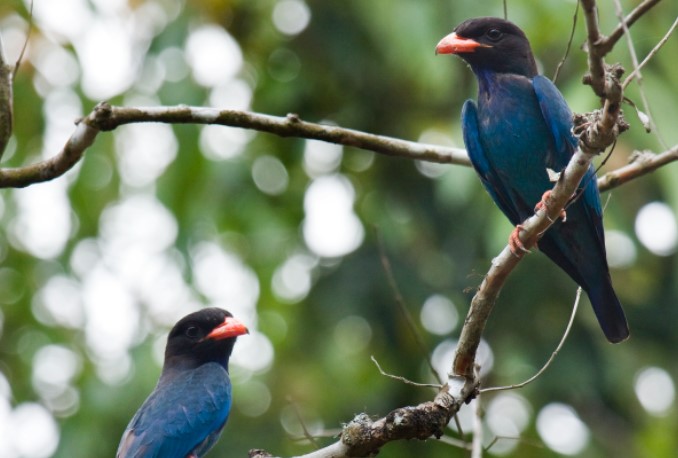Family: Known for its distinctive pale blue or white spots on its wings, the Oriental dollarbird (Eurystomus orientalis) is a member of the roller family.
Range: Australia, Korea, Japan, and India are all home to the dollarbird. The Mt Lofty-Flinders Ranges are sometimes reached by stragglers in South Australia.
Migration: The Australian race is a tropical bird that spends its winters in northern New Guinea and on some adjacent islands. It then migrates to northern and eastern Australia in the spring and summer to breed. During migration, the bird reaches heights of 2500 meters by night and by day.
Habitats: Oriental dollarbirds usually perch conspicuously on the topmost branches of tall trees near clearings just after breeding. They are usually solitary, in pairs, or at family parties. It is impossible for them to walk or hop, but they simply sit motionless, their toes partly fused for grasping, rather than perambulation.
They have broad heads, short necks, and stumpy tails that are characteristic of their silhouette. Dollarbird sorties take place from high, bare perches above clearings and treetops, launching them after insects. After prey, birds glide on long, deeply beating wings or dive and swoop in acrobatic performances. They are buoyant fliers.
Diet: In general, the heavy bill grabs flying food—beetles, bugs, moths, mantids, cicadas—and eats them on the wing, if possible, or batters them or softens them before swallowing. Dusk and early morning are the most popular times for hunting. The Oriental dollarbird is mostly seen singly on bare branches high in trees, where they hawk for insects, returning to the same perch once they have caught them.
Identification: Females are duller than males, but both sexes are similar in appearance. A dark gray-brown color covers the head and upper back, fading to a dull grey-green-blue color over the lower back and wing covers. Throughout the outer six-seven, the flight feathers are dark bluish-black with large bluish-white band-dollars. Under the wings, the color turns dull turquoise. Cobalt streaks and washes ran down his throat. Gray-brown breasts develop turquoise tones over the belly and crissum. Dark blue-black is the color of the tail. The eyes are dark brown in color. The bill is orange with a black hook. The feet are orange, and the claws are black.

Immature: more brown-grey than adults; lacks a blue throat. The area around the eye is pale, while the bill and feet are yellow-brown in color.
Vocals: Dollarbirds’ advertising voice is a harsh, ruling kak-kak-kak, repeated four-ten times in each bout; it is given by both sexes. While the female dollarbird chatters harshly to one another during the breeding season, the male dollarbird is relatively quiet in winter quarters. In flight, there is a large, round patch of blue-white on each wing that gives them their name.
Eggs: It usually lays four glossy, translucent white eggs; the Oriental dollarbird lays three to five eggs. An oval-shaped egg measures about 37 x 29 mm in size. Wood dust is found at the bottom of the cavity where the eggs are laid. Both sexes are likely to incubate. Young birds are fed by both sexes.
Distribution: Birds arrive in Australia in mid-October to breed; depart for New Guinea in late February to March, wintering primarily in the northern lowlands. Tropical forests and open woodlands are the habitats of the Oriental dollarbird. There is only one race of Eurystomus orientalis pacificus found in Australia, and it is dull and short-tailed. In southern Asia and the Solomon Islands, there are other, more colorful races.
Nesting and Breeding: Nesting and breeding season occurs in Australia in spring and summer, usually from October to January. In a tall tree, a pair of Oriental dollarbirds built a shallow, unlined nest.
Other Names: Oriental dollarbird is also called Asian dollarbirds, dark rollers, dollar rollers, dollarbirds, eastern broad-billed rollers, and oriental broad-billed rollers.
Size: The Oriental dollarbird measures approximately 260–300 mm long.
